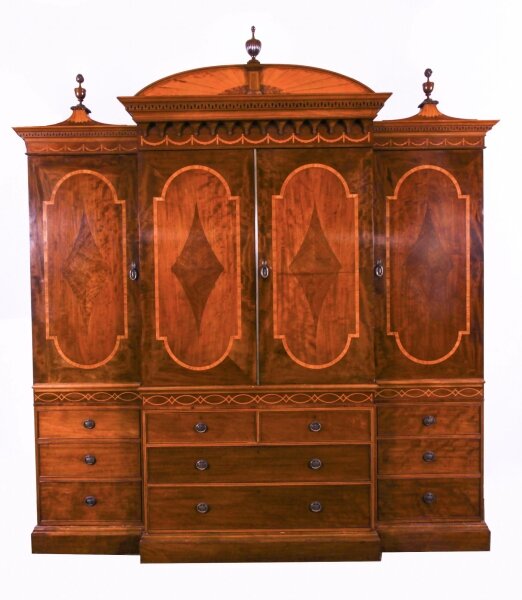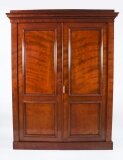Marsh, Jones & Cribb
were renowned antique furniture cabinet makers in the Victorian era. They were known for their quality craftsmanship from Gothic to simple Arts & Crafts designs. They began as cabinet makers, ca. 1850 in Leeds as Marsh & Jones of Leeds. They later expanded to Cavendish Square, London when the well known cabinetmaker of Soho, London, Henry Humphries Cribb sent his son to serve his apprenticeship with Marsh and Jones. After he had finished his apprenticeship in 1867 he was offered a partnership in the company leading to the new and well known name Marsh, Jones & Cribb.
They made antique furniture by well known designers such as Charles Bevan and Talbert and many of these pieces were in famous exhibitions.
Their earlier examples were mostly known for their Gothic appeal with Charles Bevan helping with these designs. The most sought after designs today by Marsh, Jones & Cribb are from the Late Victorian era in the Arts & Crafts design with W.R. Lethaby who was their senior designer.
The interesting thing about Marsh, Jones & Cribb furniture is the paper labels used, with their makers stamp, cabinet makers name and signature with date, all hand written.
Flame Mahogany
Thomas Sheraton - 18th-century furniture designer, once characterized mahogany as "best suited to furniture where strength is demanded as well as a wood that works up easily, has a beautiful figure and polishes so well that it is an ornament to any room in which it may be placed." Matching his words to his work, Sheraton designed much mahogany furniture. The qualities that impressed Sheraton are particularly evident in a distinctive pattern of wood called "flame mahogany."
The flame figure in the wood is revealed by slicing through the face of the branch at the point where it joins another element of the tree.
Satinwood
is a hard and durable wood with a satinlike sheen, much used in cabinetmaking, especially in marquetry. It comes from two tropical trees of the family Rutaceae (rue family). East Indian or Ceylon satinwood is the yellowish or dark-brown heartwood of Chloroxylon swietenia.
The lustrous, fine-grained, usually figured wood is used for furniture, cabinetwork, veneers, and backs of brushes. West Indian satinwood, sometimes called yellow wood, is considered superior. It is the golden yellow, lustrous, even-grained wood found in the Florida Keys and the West Indies.
It has long been valued for furniture. It is also used for musical instruments, veneers, and other purposes. Satinwood is classified in the division Magnoliophyta, class Magnoliopsida, order Sapindales, family Rutaceae.
Thomas Sheraton
(1751 - 1806) was an English cabinetmaker and one of the leading exponents of Neoclassicism. Sheraton gave his name to a style of furniture characterised by a feminine refinement of late Georgian styles and became the most powerful source of inspiration behind the furniture of the late 18th century. His four-part Cabinet-Maker and Upholsterers’ Drawing Book greatly influenced English and American design.
Sheraton was apprenticed to a cabinetmaker, but he became better known as an inventor, artist, mystic, and religious controversialist. Initially he wrote on theological subjects, describing himself as a “mechanic, one who never had the advantage of collegiate or academical education.” He settled in London c. 1790, and his trade card gave his address as Wardour Street, Soho.
Supporting himself mainly as an author, Sheraton wrote Drawing Book (1791), the first part of which is devoted to somewhat naive, verbose dissertations on perspective, architecture, and geometry and the second part, on which his reputation is certainly based, is filled with plates that are admirable in draftsmanship, form, and proportion.
In 1803 Sheraton, who had been ordained a Baptist minister in 1800, published his Cabinet Dictionary (with plates), containing An Explanation of All Terms Used in the Cabinet, Chair and Upholstery Branches with Dictionary for Varnishing, Polishing and Gilding.
Some of the designs in this work, venturing well into the Regency style, are markedly unconventional. That he was a fashionable cabinetmaker is remarkable, for he was poor, his home of necessity half shop. It cannot be presumed that he was the maker of those examples even closely resembling his plates.
Although Sheraton undoubtedly borrowed from other cabinetmakers, most of the plates in his early publications are supposedly his own designs. The term Sheraton has been recklessly bestowed upon vast quantities of late 18th-century painted and inlaid satinwood furniture, but, properly understood and used in a generic sense, Sheraton is an appropriate label recognizing a mastermind behind the period. The opinion that his lack of success was caused by his assertive character is hypothetical.


















